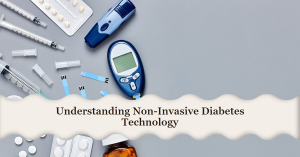
In recent years, the field of diabetes management has witnessed remarkable advancements, revolutionizing the lives of millions affected by this chronic condition. One such breakthrough is the emergence of non-invasive diabetes technology, offering a promising alternative to traditional invasive methods. In this article, we delve into the world of non-invasive diabetes technology, exploring its benefits, applications, and potential impact on diabetes care. Join us as we uncover the cutting-edge solutions that are reshaping the landscape of diabetes management.
Understanding Non-Invasive Diabetes Technology

Non-invasive diabetes technology refers to a range of innovative devices and techniques designed to monitor blood glucose levels, administer insulin, and enhance overall diabetes management without the need for painful needle pricks or invasive procedures. These technologies aim to provide individuals with diabetes with a more comfortable and convenient approach to self-care while maintaining accurate and reliable results.
Continuous Glucose Monitoring (CGM) Systems

One of the most significant advancements in non-invasive diabetes technology is the development of Continuous Glucose Monitoring (CGM) systems. CGM devices utilize tiny sensors that are placed on the skin’s surface, typically on the abdomen, to measure glucose levels in the interstitial fluid. These sensors continuously monitor glucose levels and transmit the data wirelessly to a receiver or smartphone application.
The benefits of CGM systems are multifold. Firstly, they eliminate the need for frequent fingerstick testing, offering a more comfortable and hassle-free experience for individuals managing diabetes. Secondly, CGM systems provide real-time data, allowing users to track their glucose levels throughout the day, identify trends, and make informed decisions regarding insulin dosages, dietary choices, and physical activity. By offering a comprehensive overview of glucose fluctuations, CGM systems empower individuals to achieve better glycemic control and reduce the risk of complications associated with diabetes.
Insulin Delivery Systems
In addition to continuous glucose monitoring, non-invasive diabetes technology has also made significant strides in the realm of insulin delivery. Traditionally, individuals with diabetes relied on insulin injections, which often involved needles and manual administration. However, advancements in non-invasive insulin delivery systems have transformed the way insulin is delivered, enhancing convenience, precision, and patient compliance.
One notable development is the emergence of insulin patches or “smart patches.” These small, discreet patches contain microneedles or permeable membranes that painlessly deliver insulin through the skin. By adhering to the principles of transdermal drug delivery, smart patches provide a non-invasive and needle-free method of administering insulin, reducing discomfort and simplifying the daily routine for individuals with diabetes.
Advantages and Impact of Non-Invasive Diabetes Technology
The advent of non-invasive diabetes technology has ushered in a multitude of benefits and potential impacts on the management of diabetes. Let’s explore some of the key advantages:
Enhanced Comfort and Convenience
Non-invasive diabetes technology offers a more comfortable experience for individuals with diabetes. By minimizing or eliminating the need for painful finger pricks and injections, these advancements alleviate physical discomfort and enhance overall well-being. Moreover, the convenience of real-time data tracking and remote monitoring empowers individuals to proactively manage their condition and make timely adjustments to their treatment plan.
Improved Glycemic Control
Accurate and continuous glucose monitoring provided by non-invasive devices plays a pivotal role in achieving and maintaining optimal glycemic control. By enabling individuals to monitor their glucose levels more frequently and conveniently, non-invasive technology helps identify patterns, trends, and potential triggers for blood sugar fluctuations. This information arms patients and healthcare providers with valuable insights to adjust medication dosages, modify lifestyle choices and make informed decisions for better glucose management.
Increased Adherence to Treatment
The introduction of non-invasive diabetes technology has the potential to improve treatment adherence among individuals with diabetes. The ease of use, comfort, and seamless integration into daily routines encourage patients to utilize these innovative devices consistently. By reducing barriers and streamlining the self-care process, non-invasive technology can help individuals maintain long-term treatment compliance, leading to improved health outcomes and a better quality of life.
Potential Cost Savings
While the initial investment in non-invasive diabetes technology may vary, its long-term potential for cost savings should not be overlooked. By facilitating proactive and timely interventions, non-invasive devices can help prevent acute complications and reduce the need for expensive emergency care. Additionally, better glycemic control achieved through continuous monitoring and precise insulin delivery may contribute to a reduction in long-term diabetes-related complications, potentially alleviating the financial burden associated with managing these conditions.
Conclusion
Non-invasive diabetes technology represents a transformative breakthrough in the management of diabetes. Through continuous glucose monitoring systems and innovative insulin delivery methods, these advancements offer enhanced comfort, convenience, and control for individuals living with diabetes. By leveraging these cutting-edge solutions, patients can proactively monitor their glucose levels, make informed decisions, and achieve better glycemic control. As the field continues to evolve, non-invasive diabetes technology promises to reshape the landscape of diabetes care, ultimately improving the lives of millions affected by this chronic condition.
Disclaimer: The information provided in this article is for educational purposes only and should not replace professional medical advice. Consult a healthcare professional or your primary care physician for personalized guidance and treatment options tailored to your specific needs.





